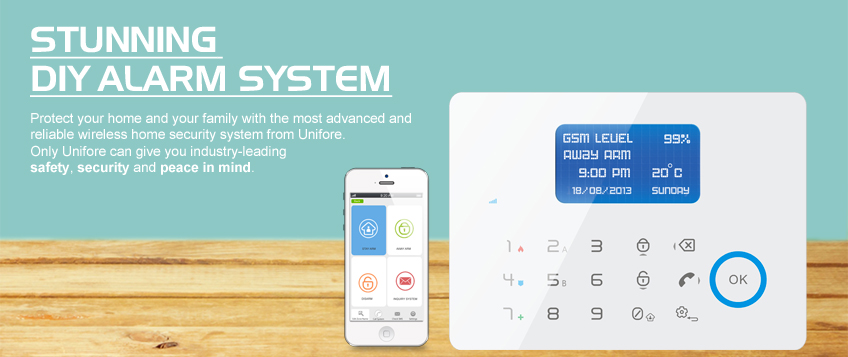
How does the wireless alarm system protect home?
We are here to help with a different approach. Assembling a home security system is not regarding choosing from a set of predetermined bundled packages, nor is it with regards to having unneeded devices tacked onto your order to drive up the expense.
Recommend the wireless alarm system
In order to simplify the installation procedures, we only recommend end-users to use the wireless alarm system. Wireless alarm systems are based on wireless connection for both communication of sensors and alarm connection. Without complicated hard-wired connection, users are easy to choose and install wireless alarm.
If you haven’t decided to buy certain system, we would like to introduce the G60-Ultimate alarm system to you. It’s top-natch wireless alarm system which has built-in GSM cellular and PSTN communicator. The system has LCD display and smart touch keypad design for intuitive operation. Most importantly, this system supports Do-it-yourself installation and allowing end-uers to program personal phone numbers for alarm receiving, without monitoring contract, even it supports smartphone app control.
Start to design alarm system for home
Let’s talk about the selection of home security system. Selecting your home security system is about ensuring it’s customized to fit your home and tailored to meet your needs. Consider it: who understands your home much better than anyone else? That’s right, it’s you! And you should be designing your system.
Foremost, protect the entry points
We know that burglars most commonly break-in from the front and back doors. From Bureau of Crime Statistics, 57 % of burglaries occur through these entry points. Focus your attention to these types of doors, either by reinforcing their security or even by adding Door Window Sensors.
Burglars are not afraid to go through windows, or even smash them. The second most common entry point for burglars is ground-level windows. Instead of investing in wireless door window sensor (magnetic contact, reed switch) for each individual window in the house, just one wireless passive infrared motion sensor can easily cover a large area with a number of windows and also detect intrusion just as effectively. You get the same safeguard for less money!
Keep in mind that windows and doors tend to be the most typical burglar entry way, but not the only way.
Protect interior rooms
We have covered the access points, however it’s preferable to be safe than sorry, and that means safe-guarding the rooms. What rooms do burglars target?
Convicted intruders have admitted that the master bedroom is usually the 1st target. It generally retains valuables which are very easily carried, for example jewelry and money. Other rooms with expensive belongings may also be primary targets, including the family room or downstairs room.
When designing your own wireless home alarm system, consider the dimensions of the room, as well as the path a burglar would have to take to enter and out. Smaller rooms may just require a Door Window Sensor, while larger types will be better appropriate with a wireless PIR motion sensor.
Interior and Perimeter protection
Start by looking at the space surrounding your property. Identify what size the area is, if there’s enough lighting and when neighbors have a good viewpoint of your yard. Intended for dark hidden places, you may think about buying motion-activated lights, or security cameras for monitoring.
An essential thing to look for is anything that could allow a intruder to gain entry to the upper levels of your home - such as trees, vines or a ladder. A burglar may opt to make use of those to get through a window on the top floor, so it’s important to secure those if you think it’s necessary.
Environmental hazards
We have focused primarily on the threat of a burglary up to now, but environmental hazards should not be disregarded. Typically, majority of wireless alarm system can work with different types of sensors for environmental hazards detection, our wireless alarm system is prepared to safeguard you from a variety of risks, including fire, freezing, flooding and carbon monoxide. When putting your system together, consider what potential dangers from nature could affect your home.
Scan me




